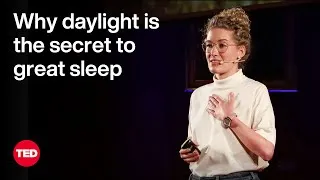請雙擊下方英文字幕播放視頻。
譯者: Helen Chang
審譯者: S Sung
00:06
There's a concept that's crucial
to chemistry and physics.
0
6875
3578
在化學和物理學中有個關鍵概念
00:10
It helps explain why physical processes
go one way and not the other:
1
10453
4840
有助於解釋是此非彼的物理現象
00:15
why ice melts,
2
15293
1556
冰為什麼會融化?
00:16
why cream spreads in coffee,
3
16849
2430
奶油為什麼會在咖啡裡散開來?
00:19
why air leaks out of a punctured tire.
4
19279
3250
為什麼穿了孔的輪胎會漏氣?
00:22
It's entropy, and it's notoriously
difficult to wrap our heads around.
5
22529
4510
這是「熵」的概念,非常難以理解
00:27
Entropy is often described as
a measurement of disorder.
6
27039
4840
有個說法常把熵
用來衡量不規則的程度
00:31
That's a convenient image,
but it's unfortunately misleading.
7
31879
3860
雖然合宜,卻很容易誤導
00:35
For example, which is more disordered -
8
35739
2772
例如,下列哪種情形比較不規則呢?
00:38
a cup of crushed ice or a glass
of room temperature water?
9
38511
4958
一杯碎冰,還是一杯室溫的水?
00:43
Most people would say the ice,
10
43469
1904
大多數人認為冰比較不規則
00:45
but that actually has lower entropy.
11
45373
3696
但實際上冰的熵值比水低
00:49
So here's another way of thinking
about it through probability.
12
49069
3829
另一種理解熵的方法是透過機率
00:52
This may be trickier to understand,
but take the time to internalize it
13
52898
4392
雖或不易理解,但請耐心內化
00:57
and you'll have a much better
understanding of entropy.
14
57290
3970
就會更理解熵
01:01
Consider two small solids
15
61260
2401
想像兩小塊固體
01:03
which are comprised
of six atomic bonds each.
16
63661
3880
各自有六根原子鍵
01:07
In this model, the energy in each solid
is stored in the bonds.
17
67541
5240
這模型裡的能量存在固體的原子鍵裡
01:12
Those can be thought of
as simple containers,
18
72781
2511
可以把原子鍵想成簡單的能量容器
01:15
which can hold indivisible units of energy
known as quanta.
19
75292
4778
裡面裝著不可分割的
能量單位「量子」
01:20
The more energy a solid has,
the hotter it is.
20
80070
4531
固體的能量越高就越熱
01:24
It turns out that there are numerous
ways that the energy can be distributed
21
84601
4441
這兩個固體
有許許多多的能量分佈方式
01:29
in the two solids
22
89042
1510
01:30
and still have the same
total energy in each.
23
90552
4040
而各自的總能量不變
01:34
Each of these options
is called a microstate.
24
94592
3910
每一種能量分佈方式稱為一「微態」
01:38
For six quanta of energy in Solid A
and two in Solid B,
25
98502
4839
假如固體甲有六個量子,而乙有兩個
01:43
there are 9,702 microstates.
26
103341
4491
那麼就共有 9,702 種微態
01:47
Of course, there are other ways our eight
quanta of energy can be arranged.
27
107832
5029
當然還有其它分派八個量子的方式
01:52
For example, all of the energy
could be in Solid A and none in B,
28
112861
4972
例如,固體甲擁有八個量子
而固體乙一個也沒有
01:57
or half in A and half in B.
29
117833
3039
或者甲乙各分一半
02:00
If we assume that each microstate
is equally likely,
30
120872
3282
如果假設每種微態發生的機率相等
02:04
we can see that some of the energy
configurations
31
124154
2640
就會看到某些能量分佈狀態
02:06
have a higher probability of occurring
than others.
32
126794
3749
發生的機率高過其他狀態
02:10
That's due to their greater number
of microstates.
33
130543
3641
原因是它們的微態總數比較多
02:14
Entropy is a direct measure of each
energy configuration's probability.
34
134184
5959
熵直接衡量每種能量分佈狀態的機率
02:20
What we see is that the energy
configuration
35
140143
3050
呈現出的是
這兩個固體的能量最分散的時候
02:23
in which the energy
is most spread out between the solids
36
143193
3650
02:26
has the highest entropy.
37
146843
2081
熵值最高
02:28
So in a general sense,
38
148924
1550
一般而言
02:30
entropy can be thought of as a measurement
of this energy spread.
39
150474
4379
可把熵想成是能量散佈的指標
02:34
Low entropy means
the energy is concentrated.
40
154853
3040
低熵值代表能量集中
02:37
High entropy means it's spread out.
41
157893
3730
而高熵值代表能量分散
02:41
To see why entropy is useful for
explaining spontaneous processes,
42
161623
4142
為要理解怎樣用熵解釋自發過程
02:45
like hot objects cooling down,
43
165765
2310
像是熱的物體冷卻下來
02:48
we need to look at a dynamic system
where the energy moves.
44
168075
4359
必須看能量的動態流動
02:52
In reality, energy doesn't stay put.
45
172434
2501
實際上,能量並非靜止不動
02:54
It continuously moves between
neighboring bonds.
46
174935
3130
而是持續在相鄰的原子鍵中移動
02:58
As the energy moves,
47
178065
2141
隨著能量移動
03:00
the energy configuration can change.
48
180206
2749
能量的分佈跟著改變
03:02
Because of the distribution
of microstates,
49
182955
2130
根據微態的分佈
03:05
there's a 21% chance that the system
will later be in the configuration
50
185085
4751
有 21% 的機率
後來會進入能量最分散的狀態
03:09
in which the energy is maximally
spread out,
51
189836
3759
03:13
there's a 13% chance that it will
return to its starting point,
52
193595
3762
有 13% 的機率回到初始狀態
03:17
and an 8% chance that A will actually
gain energy.
53
197357
5500
還有 8% 的機率
固體甲會增加能量
03:22
Again, we see that because there are
more ways to have dispersed energy
54
202857
4078
再次重申,因為分散能量
03:26
and high entropy than concentrated energy,
55
206935
3091
高熵值的微態總數
比能量集中的還多
03:30
the energy tends to spread out.
56
210026
2532
因而能量趨向分散
03:32
That's why if you put a hot object
next to a cold one,
57
212558
2951
這就是為什麼把熱的物體
和冷的物體擺一起
03:35
the cold one will warm up
and the hot one will cool down.
58
215509
4911
冷的會變熱,而熱的會變冷
03:40
But even in that example,
59
220420
1447
但是同一個例子
03:41
there is an 8% chance that the hot object
would get hotter.
60
221867
5249
也有 8% 的機率
熱的物體會變得更熱
03:47
Why doesn't this ever happen
in real life?
61
227116
4311
為什麼現實生活裡沒發生這種情形?
03:51
It's all about the size of the system.
62
231427
2750
原因在於系統的規模
03:54
Our hypothetical solids only had
six bonds each.
63
234177
3880
我們的模型假設
只有六根原子鍵的固體
03:58
Let's scale the solids up to 6,000 bonds
and 8,000 units of energy,
64
238057
5881
如果增加到 6,000 根原子鍵
和 8,000 個單位能量
04:03
and again start the system with
three-quarters of the energy in A
65
243938
3589
初始狀態仍是甲有四分之三的能量
04:07
and one-quarter in B.
66
247527
2600
而乙有四分之一的能量
04:10
Now we find that chance of A
spontaneously acquiring more energy
67
250127
4210
就會發現甲自發獲得更多能量的機率
04:14
is this tiny number.
68
254337
2910
是個這麽微小的數字
04:17
Familiar, everyday objects have many, many
times more particles than this.
69
257247
5061
日常熟知物體的粒子數遠比這多得多
04:22
The chance of a hot object
in the real world getting hotter
70
262308
3612
所以現實世界裡
熱的物體變得更熱的機率
04:25
is so absurdly small,
71
265920
2091
小得荒謬
04:28
it just never happens.
72
268011
2398
乃至根本不會發生
04:30
Ice melts,
73
270409
1119
冰塊融化
04:31
cream mixes in,
74
271528
1390
奶油和咖啡混合在一起
04:32
and tires deflate
75
272918
1758
輪胎放氣
04:34
because these states have more
dispersed energy than the originals.
76
274676
5266
都是因為這些狀態的能量
比原先狀態的更分散
04:39
There's no mysterious force
nudging the system towards higher entropy.
77
279942
3688
並不是某種神秘的力量
驅使系統傾向微調至更高的熵值
04:43
It's just that higher entropy is always
statistically more likely.
78
283630
5298
而是因為統計上高熵值更可能發生
04:48
That's why entropy has been called
time's arrow.
79
288928
3552
這就是為什麼熵又被稱為時間之箭
04:52
If energy has the opportunity
to spread out, it will.
80
292480
4259
如果有機會分散能量,就會分散能量
New videos
關於本網站
本網站將向您介紹對學習英語有用的 YouTube 視頻。 您將看到來自世界各地的一流教師教授的英語課程。 雙擊每個視頻頁面上顯示的英文字幕,從那裡播放視頻。 字幕與視頻播放同步滾動。 如果您有任何意見或要求,請使用此聯繫表與我們聯繫。







